Neurodiversity information for parents and young people
Hearing services available to help your child
A range of hearing services teams are available to help your child.
Paediatric audiology team
Audiologists are healthcare professionals who identify and treat hearing problems.
Your child’s audiologists will do the following:
- Measure your child’s hearing levels and test how much hearing your child has.
- Explain the different types of hearing tests available so they can help your child hear as well as possible.
- Prescribe personal hearing aids, sound processors and other listening equipment.
- Give advice on how you can encourage your child to wear hearing aids.
- Show you how to care for your child’s hearing aids.
- Offer advice on how to change your child’s everyday environment so they can hear better.
- They may refer your child to specialist services, for example to a Cochlear Implant Centre. They will discuss this with you first.
|
Your child’s paediatric audiologists are:
|
Physical & Sensory Support
Physical & Sensory Support is a team of experienced Teachers of the Deaf. They work in the home, in nurseries, schools, colleges and universities. They provide:
- individual support for children with hearing loss
- guidance to parents and families of children with hearing loss
- advice on options for education
- advice and information on access to the national curriculum (education)
- advice and support on managing hearing amplification and assistive listening devices as appropriate
- a link between the different services working with children with hearing loss.
|
Your child’s PSS lead (Teacher of the Deaf) is:
|
Speech and language therapy
Speech and language therapists are trained to assess and improve speech and language development. Some of these therapists have specialised training and experience in working with children who are deaf, hard of hearing or deaf blind.
|
Your child’s speech and language therapist is:
|
Specialist teams
Ear, Nose and Throat (ENT) specialists are doctors who specialise in treating ear, nose and throat conditions.
|
Your child’s ENT specialist is:
|
Paediatricians
Paediatricians offer advice on childhood problems. These may include problems relating to development, behaviour, general health and special educational needs.
Your audiologist may recommend referring your child to a paediatrician to investigate why your child has a hearing loss.
Types of hearing loss
The audiogram below can help you understand your child’s level of hearing.
Audiogram of familiar sounds
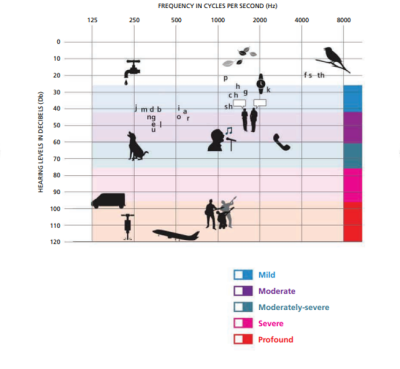
| Mild |
May have difficulty hearing quiet or distant voices. Likely to experience some difficulty in communication and education settings and become easily tired. An increased sound volume will help them to hear better. |
| Moderate |
Can often understand conversational speech when facing the speaker and being close to the speaker. Can miss 50% or more of the speech signal if they do not use a hearing aid. Will need to use hearing aids. They may require extra support in school, for example a radio aid or a better choice of seating and lighting. A radio aid is an assistive listening device. It will help them cope with noise in the classroom. It will also help them cope with being far away from the person speaking in the classroom. |
| Moderately severe |
Can only hear conversation when it is loud. Can miss up to 100% of speech information if they do not wear a hearing aid. Can hear a normal conversational voice if they use a correctly programmed hearing aid. Will benefit from extra help in school (for example a radio aid or a better choice of seating and lighting. Will benefit a great deal from using a radio aid all the time. |
| Severe |
May be able to hear extra loud voices if they are close to the people speaking. Will need to use hearing aids to hear conversational speech and environmental sounds. Will benefit from a radio aid. |
| Profound |
Will need to wear appropriate technology to make sounds louder. For example hearing aids, a cochlear implant or a radio aid can help them hear conversational speech. Will benefit from a radio aid and extra help at school (for example visual cues and preferential seating). |
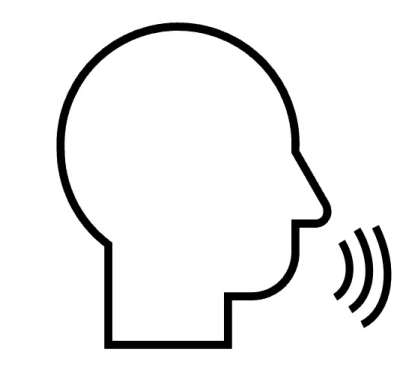
Speak to your paediatric audiologist if you want more information on radio aids and how they can help your child.
Hearing aids and children
How can a hearing aid help my child?
A hearing aid is a system that makes all sounds louder. It does not give your child the ability to hear fully, but it does make the most of their existing hearing ability.
Some sounds and speech will not always be clear and may sound different.
Your child will probably notice many sounds that they have not heard for a while.
The more your child gets used to using a hearing aid system, the more sounds they will learn to recognise and accept.
Willingness to wear a hearing aid
Sometimes a child prefers not to wear a hearing aid. There are many reasons for this. The most common are:
- Sounds feel unfamiliar and frightening, or too loud.
- They don’t like having something in their ear canal.
- They feel embarrassed or self-conscious about wearing it.
- The earmould is uncomfortable.
- The hearing aid does not fit comfortably behind the ear.
How can I help my child get used to wearing a hearing aid?
The more your child gets used to using a hearing aid system, the more sounds they will learn to recognise and accept.
- Your child’s age, and the extent of their hearing loss, will determine how often they need to wear the hearing aid.
- We recommend you gradually introduce your child’s hearing aid use into everyday activities.
- They can use it at home for the first few weeks.
- They can gradually start wearing it at school and in the outside world.
- Most children wear their hearing aids all day. A few children only wear them in certain situations, for example at school.
How can I tell if my child’s hearing aid is helping them to hear better?
Children do not always express themselves and tell us how well or poorly a hearing aid is working.
Your observations will help us to adjust your child’s hearing aid(s) when needed.
- Watch how your child acts when they use the hearing aid(s).
- Talk about your observations with your partner or other adults.
- Remember things may change as your child gets used to the hearing aid(s).
- A few days before your child’s next appointment, make a list of your observations. You may want to discuss them with the audiologist.
How to use your hearing aid
Follow the instructions in the tables below.
Turning your hearing aid on and off
| On To switch the hearing aid on, close the battery compartment. |
 |
| Off To switch the hearing aid off open the battery compartment. Do this when you are not using the hearing aid, to save battery life. |
 |
Removing and replacing the battery
| Open the battery compartment using your finger. |  |
|
Usually the battery drops out when the compartment is completely open. |
 |
| Insert the correct size battery. (Your paediatric audiologist will tell you which kind of battery you need when the hearing aid is fitted). Make sure that the + symbol on the battery points upwards. |
 |
| Close the battery compartment. Do not force the door shut. If it does not close easily, check to see that the battery has been inserted correctly. When the battery door is completely closed, your hearing aid is ready for use. |
 |
Removing and replacing the battery on a hearing aid with a tamper proof battery door
If your child or their sibling(s) are younger than 5 years of age, we will fit a tamperproof battery door to your child’s hearing aid. This will prevent a young child from accessing the battery.
| Open the tamper proof battery compartment using the plastic tool. Change the battery as described above (see Removing and replacing the battery). |
 |
Hearing aid battery safety
Children under 5 years old
- Try not to let young children watch when you change the batteries.
- It is safer if they do not know how to open the battery compartment.
- Hearing aids for children under 5 years of age usually have tamper proof (childproof) battery lock. We will give you a small plastic tool to unlock the tamper proof battery door.
- These tamper proof battery locks are especially useful if your child has brothers or sisters, or if they are cared for with children who are younger than 5 years old.
If you are not sure, ask your audiologist whether your child’s hearing aid has a childproof battery lock.
Children over 5 years old
Speak to your audiologist if your child is over 5 years old and you feel they may benefit from a tamper proof battery lock.
What do I do if my child swallows a battery?
If your child swallows a battery, immediately contact your nearest Emergency Department (A&E).
Tell them what type of battery your child has swallowed and approximately when they swallowed it.
Take a similar battery and the packaging with you to the Emergency Department (A&E) so hospital staff can identify the type of battery. This will help them decide what action they need to take.
Young children can also get small batteries stuck in their nose and ears. Sometimes this goes undetected until they develop ulcers or tissue damage.
Always keep a check on the number of batteries that you have at home.
![]()
Contact your nearest Emergency Department (A&E) if your child swallows a battery.
How do I safely dispose of used batteries?
Get rid of used batteries carefully as they contain chemicals that can be harmful. You can:
- Safely dispose of them in your normal household rubbish bags.
- Take them to your local recycling centre (check with your local council before you go).
- Take them to local supermarkets if they offer a recycling box for used batteries. Check before you go.
Daily hearing checklists
Daily hearing aid checklist
Use this hearing aid checklist every day.
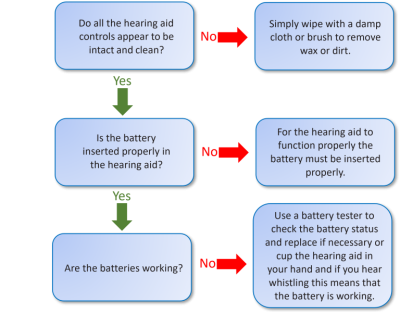
Daily listening checklist
Use the listening tubes provided in your child’s hearing aid care pack to complete the daily listening check.
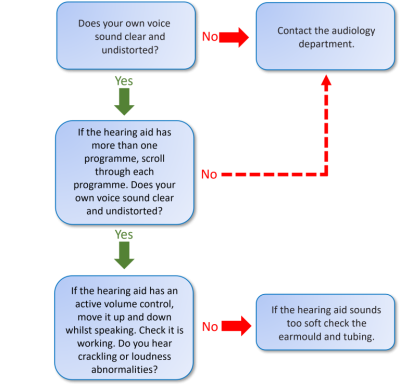
Daily earmould checklist
Use this earmould checklist every day.
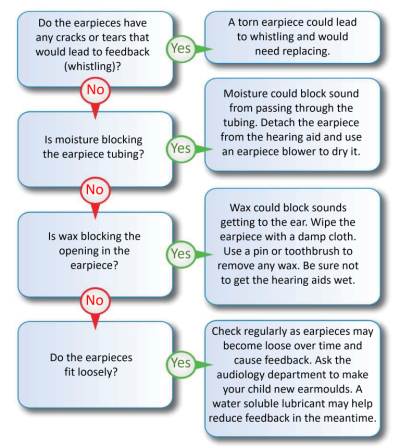
Hearing aid maintenance
Cleaning the earmoulds
| Detach the earmould from the hearing aid. To do this squeeze the tubing near the hearing aid and pull the aid from the tubing. |
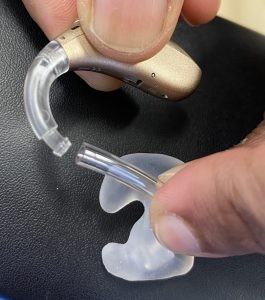 |
| Leave the earmould in a solution of warm soapy water for 30 minutes. Use a safety pin or a sewing pin to remove any wax that is blocking the earmould. Run warm water over and through the earmould to clear the soap. |
 |
| Dry the earmould with a tissue or kitchen paper. Blow through the tubing to ensure no water is left in the tubing. (Water left in the tubing will damage the aid when it is reattached.) If you have been given a puffer, pop it in the end of the tubing and give it a blow. This will dry out any water or condensation which has built up in the tubing. |
 |
| Reattach the earmould to the hearing aid by squeezing the tube. |  |
| Ensure the earmould and hearing aid are connected correctly. Fit them together correctly by placing the earmould curve to the inside of the curve of the hearing instrument. |
 |
| The picture shows the left side correctly connected. |  |
| The picture shows the right side correctly connected. |  |
Remember
Make sure your hearing aid never gets wet.
Retubing the earmould
You will need to change the tubing when it begins to harden, changes colour or splits.
Your audiologist will show you how to change the tubing. You can also take it to a hearing aid repair session run by the audiology department.
|
Step 1 |
 |
| Step 2 Cut the last 5cm (2 inches) of a piece of pre bent tube to a tapered end. Thread this through the earmould until it comes out the other end. |
 |
| Step 3 Pull the tube until the bend reaches the earmould. All the tapered section should have come through the other side. |
 |
| Step 4 Cut the tapered tubing as close as possible to the earmould to avoid any rough edges that might be uncomfortable in the ear. (Any tube sticking out could rub your ear and make it sore.) |
 |
| Step 5 Take the old piece of tubing you saved and line it up with the newly threaded tube. Cut the end to the same length. |
 |
| Step 6 Push the end of the tubing onto the plastic nozzle of your hearing aid. Make sure that it bends in the right direction. |
 |
Moving over to adult audiology services
This section is for teenagers and young adults who are about to start moving over to the adult audiology service.
It prepares you for the adult audiology service and supports you through the move from secondary school to university or employment.
Most young people begin to move over to the adult audiology service between 16 and 21 years. Your final transition to the adult audiology service will take place when you are ready. This usually occurs when you have started university or work.
Your transition appointments are similar to your current paediatric audiology appointments. They also cover the following:
- what to expect when you move over to adult audiology
- learning to use your hearing aids independently
- moving on to University
- applying for disabled student’s living allowance, support in lectures and equipment to use
- support in the workplace: Access to Work
- equipment for your home
- benefits and other services.
Arrange an appointment with your paediatric audiologist if you have queries about transition to adult audiology services.
You can also request an information booklet on transition to adult audiology (see More information section below).
Repair service and replacement battery services
Below you will find details of the repair service and various local replacement battery services.
Repair service
The repair service offers the following
- hearing aid checks
- replacement of lost hearing aids
- advice on how best to use hearing aids
- replacement tubes, domes and earmoulds (these are all parts of a hearing aid).
If you need a hearing aid repair, use one of the following services
In-person collection or drop-off
To collect replacement batteries or tubes and to drop hearing aids off for repair or servicing.
Go to the audiology department reception and give them your NHS hearing aid service book and hearing aids.
The audiology department reception is open Monday to Friday, 9am to 4pm.
By post
Post your NHS hearing aid service book and hearing aids to us.
Include a note to tell us what you want us to do (see Contacts section below).
In-person appointment
Contact us to arrange an appointment (see Contacts section below).
Replacement battery services
Use the drop-down menu for information on local replacement battery services.
All of the following offer replacement battery services.
The Orchard Practice
Orchard Gardens
Chessington KT9 1AG
Claygate Centre
Elm Road
Claygate KT10 0EH
Molesey Clinic
Walton Road
East Molesey KT8 2HZ
Centre House
Sheen Lane
East Sheen SW14 8LP
The Civic Centre (Elmbridge Council)
High Street
Esher KT10 9DS
Groves Surgery
Station Approach
Hinchley Wood KT10 0SP
Holmwood Corner Surgery
Malden Road
New Malden KT3 6DR
Age Concern (Raleigh House)
Nelson Road
New Malden KT3 5EA
Richmond Rehabilitation Unit
Evelyn Road
Richmond TW9 2TF
Ham Clinic
Ashburnham Road
Richmond TW10 7NF
Alfriston Centre
Berrylands Road
Surbiton KT5 8RB
Claremont Medical Centre
Glenbuck Road
Surbiton KT6 6BS
Surbiton Health Centre
Ewell Road
Surbiton KT6 6EZ
Teddington Health & Social Care Centre
Queens Road
Teddington TW11 0LR
Molesey Centre for the Community
Bishop Fox Way
West Molesey KT8 2AS
Whitton Corner Health and Social Care Centre
Percy Road
Whitton TW2 6JL
Manor Drive Clinic
Manor Drive
Worcester Park KT4 7LG
More information
Surrey Deaf Children’s Society (SDCS)
National Deaf Children’s Society
Achieving for Children information on carers
Achieving for Children’s Family Information Service
Delta Deaf Education through listening and talking
RNID (Royal National Institute for the Deaf)
SENSE, helping people who are deafblind or have complex disabilities.
Child Accident Prevention Trust
Kingston Hospital information on moving to adult audiology services
Children’s Hearing Services Working Groups (CHSWG)
Local CHSWGs ensure that all services work together to support deaf children and their families. Each group includes representatives from health, social services, education, the local voluntary sector and parents of deaf children.
Talk to your child’s audiologist or Teacher of the Deaf if you would like to become involved or would like more information.
Contact information
Kingston Hospital Audiology Department. Monday to Friday, 9 am to 5 pm. Email: khft.
Teddington Memorial Hospital, Paediatric Audiology, 1st Floor Outpatients, 11 Hampton Road,TW11 0JL
Queen Mary's Hospital Audiology Department, Queen Mary's Hospital, Roehampton Lane, Suite 1, London SW15 5PN. Monday to Friday, 9 am to 5 pm. Email: khft.
The Orchard Centre, Unit 8 Orchard Business Park, Bonehurst Road, Salfords, Redhill RH1 5EL. Monday to Friday, 9 am to 5 pm. Email: khft.
Telephone:
Kingston Hospital Audiology Department: 020 8934 6406 option 1
Teddington Memorial Hospital Paediatric Audiology: 020 8714 4108
Queen Mary's Hospital Audiology Department: 020 8934 6406 option 1
The Orchard Centre: 01483 362 619 (appointments)